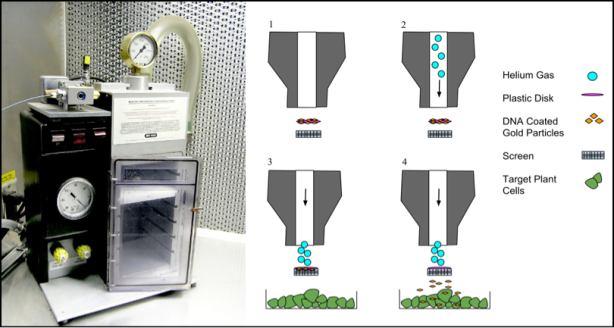Have you seen the movie Avatar? I remember being captivated by the colorful world of Pandora, where the Na’vi lived. Some of the most picturesque scenes take place in the forest, whose floor is decorated with bioluminescent plants and fungi, much like that shown in Figure 1. They all emit their colorful glow as Jake learns about the Na’vi culture from Neytiri. Believe it or not, this fantastical imagery is related to modern-day nanotechnology!

Much like the plants of Pandora, there is a real orchid capable of bioluminescence, created by Professor Chia Tet Fatt of Singapore’s National Institute of Education in 1994.1 He did so by using genetic engineering to add the luciferase gene from fireflies (the gene that makes them glow) to the orchid’s DNA, thereby allowing the orchid to glow like fireflies (Figure 2). If you wanted one of these orchids to light up your home, they were auctioned after their creation for a minimum bid of $200,000!2 The technique used to create these glow-in-the-dark plants is called biolistics.

Biolistics begins with adding the DNA of your choice (in this case, the luciferase gene from fireflies) to a metal bead, commonly made of gold or tungsten. A bunch of these DNA-coated beads are loaded into a “gene gun,” also called a biolistic particle delivery system (Figure 3), to be fired at the cells of interest (in this case, orchid cells). The DNA on the beads can then incorporate into the DNA of the plant. It often takes several generations of careful cultivation to get plants that have the new gene expressed throughout.

In the case of Professor Chia, the tungsten bullets used to make the luminescent orchid 20 years ago were on the microscale, measuring at about a 1.2 µm diameter. But now, some researchers are using nanomaterials in biolistics,3 which imparts some new benefits to the method. By using smaller particles, the gene gun can be used on a wider range of cell types, including smaller cells or even specific locations on cells, such as the dendrites of neurons (Figure 4), which are too small to have new DNA added to them by microparticles. To take that a step further, specific organelles in cells can be targeted when using nanoparticles, which allows for a more directed procedure. Also, the use of nanoparticles in this technique minimizes tissue damage from firing metal beads at a specimen.

One exciting application of the gene gun is in developing a new therapy for Duchenne muscular dystrophy, a genetic disease that causes muscle deterioration. In a study using mice, biolistics was used to deliver the dystrophin gene (the defective gene in Duchenne muscular dystrophy) to muscle fibers in the mice, which resulted in an improvement in the function of their muscles.4 This therapy, as well as other gene therapies using biolistics, could benefit from the replacement of microparticles with nanoparticles, since the smaller-sized nanoparticles lead to less tissue damage (a benefit for any medical treatment).
While I recognize that genetic engineering of food crops is a controversial subject, biolistics has also been used for this purpose. For example, the European corn borer is a pest that infects corn (Figure 5), killing a lot of the crop and costing farmers billions of dollars in damage per year.5 To combat this, farmers often spray their corn multiple times a year with an insecticide containing a protein from the bacterium, Bacillus thuringiensis, which kills Lepidoptera larvae, such as those of the European corn borer. To remove the need for applying large amounts of insecticide, corn that can produce its own Bt protein, called Bt corn, was created using biolistics.6 This has helped to improve the yield of corn for farmers. There is always the possibility that the pests will gain resistance to these crops, which means this may not be a perfect, long-term fix. Some other biolistic genetic engineering projects that may be done in the future include research to improve the nutritional content of food, such as creating fruit with higher levels of important antioxidants.

As you can see, genetic engineering has been used for various purposes, but it’s not without its limits. Incorporating nanotechnology into the biolistics method of genetic engineering will help expand the uses of that technique, paving the way for many new and exciting applications. That said, while genetic engineering can be used to solve some of the problems we face today, I’m not sure that it will ever be used to populate our forests with luminescent plants. Those types of scenes will likely be saved for the movies.
EDUCATIONAL RESOURCES
- New York Times Learning Network: ‘Hunger Games’ Science: Investigating Genetically Engineered Organisms by Jennifer Cutraro & Katherine Schulten
- National Geographic Society: Bioluminescence: Living Light activity (grades 3-5)
- National Oceanic & Atmospheric Administration: Lesson Plans for the Bioluminescence 2009: Living Light on the Deep Sea Floor Expedition (series of lesson plans for grades 5-12)
REFERENCES
- Chia, T.-F., Chan, Y.-S., & Chua, N.-H. The Firefly Luciferase Gene as a Non-Invasive Reporter for Dendrobium Transformation. The Plant Journal. 1994, 6 (3), 441–446. doi: 10.1046/j.1365-313X.1994.06030441.x
- The Arizona Orchidist Newsletter. 2000. Retrieved from http://www.orchidsocietyaz.org/1100.htm.
- O’Brien, J. & Lummis, S. Nano-Biolistics: A Method of Biolistic Transfection of Cells and Tissues Using a Gene Gun with Novel Nanometer-Sized Projectiles. BMC Biotechnology. 2011, 11 (66). doi: 10.1186/1472-6750-11-66
- Zelenin, A. et al. Bacterial β-Galactosidase and Human Dystrophin Genes Are Expressed in Mouse Skeletal Muscle Fibers after Ballistic Transfection. FEBS Letters. 1997, 414, 319–322. doi: 10.1016/S0014-5793(97)01019-3
- Witkowski, J. et al. Bt corn and European corn borer. University of Minnesota Extension: Corn Production [website]. Retrieved from http://www.extension.umn.edu/agriculture/corn/pest-management/bt-corn-and-european-corn-borer/.
- Adnan, A. Bt Corn: Method, Mode of Action and Benefits. Biotech Articles. 2010. [website] Retrieved from http://www.biotecharticles.com/Agriculture-Article/Bt-Corn-Method-Mode-of-Action-and-Benefits-236.html.
